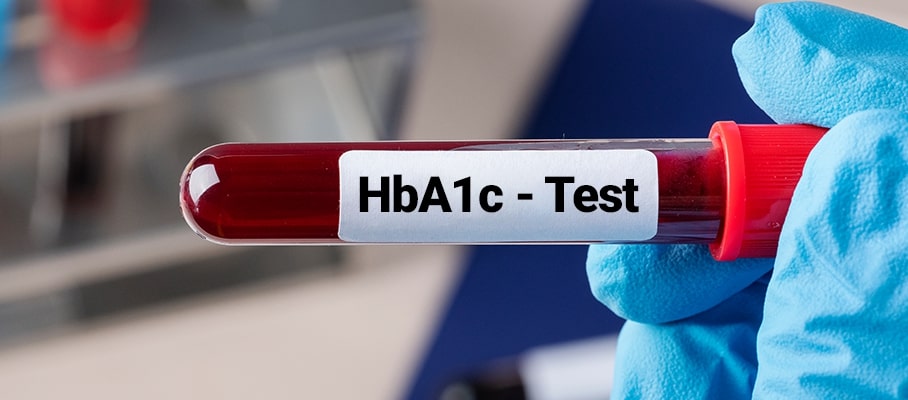We have all heard of the term hemoglobin before. Hemoglobin, denoted HB, is found in the RBC (red blood cells). The RBC carries oxygen in the human body, and it is hemoglobin that gives blood its red color.
Hemoglobin is an important protein and several people have gotten a hemoglobin test at some point in their life. A hemoglobin test is very common and every day, lakhs of people get it done. However, glycosylated hemoglobin is relatively uncommon to hear. Let us discuss more about it in detail.
A glycosylated haemoglobin test is conducted to measure the amount of glucose in the blood. This test is less common than a normal hemoglobin test. Glucose is another name for sugar.
What is glycosylated hemoglobin?
As mentioned earlier, glycosylated hemoglobin refers to the amount of sugar present in the blood. As we know, sugar is one of the most harmful substances for the human body. While sugar is an important nutrient as well, its consumption or presence in high quantities can be harmful to human health.
What does high glycosylated hemoglobin indicate?
High levels of glycosylated hemoglobin indicate the presence of high levels of glucose in the blood. Similarly, low glycosylated hemoglobin indicates low levels of glucose in the blood.
Normal and abnormal glycosylated hemoglobin:
The normal range of glycosylated hemoglobin differs in different groups of people. Although people who do not have diabetes also have certain levels of glucose in their blood, this term is usually associated with people who have diabetes. There is another term called prediabetes. This refers to people who do not have diabetes yet but are at a higher risk of getting diabetes in the future.
The normal levels of glycosylated hemoglobin for these groups are:
- People without diabetes- people without diabetes normally have hemoglobin A1c levels between 4% to 5.6%.
- Prediabetes- levels between 5.7% to 6.4 indicate prediabetes. This means that you currently do not have diabetes but are at a high risk of getting it in the future. Prediabetes is the indication that you should start avoiding overconsumption of sugar and maintain an active lifestyle.
- People with diabetes- levels 6.5% and above mean that a person has diabetes.
What is a glycosylated haemoglobin test used for?
A glycosylated hemoglobin test may be suggested due to various reasons. It is suggested by the doctor for the following purposes:
- To diagnose diabetes- if the doctor feels you might have diabetes, he or she might prescribe a test for ruling out the disease. People with diabetes must maintain a healthy and active lifestyle.
- To diagnose Prediabetes- people who do not have diabetes but show symptoms might be asked to take a glycosylated hemoglobin test to check the glucose levels in the blood. Based on the report, a doctor might suggest precautionary measures, medicines if required, etc.
- Routine checkups- if you have a family history of diabetes, doctors might recommend routine checkups to monitor your glucose levels.
- Visible symptoms of diabetes- doctors recommend this test if he or she feels you have symptoms of diabetes. Since diabetes cannot be cured and poses serious life threats, it is important to check your glucose levels regularly.
Diabetes is becoming increasingly common. As a result, the doctors always keep warning people. Doctors recommend this test to both people with and without diabetes.
If you haven’t been diagnosed with diabetes yet but show these symptoms, you might be asked to get a glycosylated hemoglobin test:
- Blurry vision- if a person complains of having blurry vision, it is usually corrected with eyeglasses. With the overuse of electronic gadgets and increasing screen time, many people have started developing problems seeing. But if your vision keeps deteriorating, it is not a good sign. You might be suggested to take this test in this case.
- Fatigue and tiredness- some people feel tired and lethargic all the time. It is very unhealthy. Fatigue and constant tiredness can be a sign of underlying diseases.
- Increased urination- while urination helps throw out the body’s toxins, frequent urination is not good. If you are experiencing frequent urination, this test may be recommended to you.
These are some circumstances under which people who do not have diabetes are suggested to take the glycosylated haemoglobin test. But if you are at the risk of getting diabetes, you might be suggested this test too. The reasons include:
- Family history- since family history plays a crucial role in the passing on of diabetes, doctors suggest regular tests for keeping diabetes under check. So, if someone in your family has diabetes, you might be asked to take the test too.
- Obesity- obesity is directly linked to diabetes. While obesity is harmful irrespective of whether a person has diabetes or not, if you are already at risk, you might be suggested to take the test too.
- Hypertension or high blood pressure- high BP and hypertension are sadly becoming common too. If a person is already at high risk and constantly has high BP, he or she might be recommended to take the test as well.
Apart from these symptoms, people of old age might be recommended taking this test as well as a part of routine checkups. Increasing levels of glucose is an alarming sign and the person in question should take it very seriously.
This test is taken in the same way as most other tests. Labs require a blood sample collected from the person by inserting a needle into the nerves. Although no special preparations are usually required, it is suggested to take the test in the morning.

